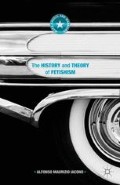Abstract
0. What import can the presentation of research carried out into fetishism have? To answer this question we must stop and look around us. We are literally surrounded by fetishes, that is to say, by objects endowed with qualities pertaining to human Relationships. Despite their familiar appearance, it is precisely by virtue of these qualities that they take on a different aura. In this process, lifeless things come to life and, at the same time, they beguile and fascinate people. Any discussion of these mechanisms necessitates a reflection on cognitive processes, focusing attention not only on the Relations between the self and others or the self and the world, but also on the Relation of the self with the self. It is also a means to keep one’s critical awareness alive when entering places that are unRelated to the real world and are outside of time: those Platonic caves where fiction loses its frame and where the boundaries between the real and virtual world collide. Shopping centers—places where the consumer is free to look at fetish commodities without necessarily having to buy them—are an example of this.
Access this chapter
Tax calculation will be finalised at checkout
Purchases are for personal use only
Preview
Unable to display preview. Download preview PDF.
Notes
D. Hume, The Natural History of Religion, with an Introduction by John M. Robertson, Freethought Publishing Company, London, 1889.
E. B. Tylor, Primitive Culture (1871), New York, Brentano, 1924, vol. I, p. 477 ff;
S. Freud, Totem and Taboo, translated by A. A. Brill, New York, Moffat, 1918.
D. Freedberg, The Power of Images, University of Chicago, Chicago, 1989.
See also D. Freedberg and V Gallese, “Motion, Emotion and Empathy in Aesthetic Experience,” Trends in Cognitive Sciences, 11, 2007, pp. 197–203;
V. Gallese and D. Freedberg, “Mirror and Canonical Neurons Are Crucial Elements in Aesthetic Response,” Trends in Cognitive Sciences, 11, 2007, p. 411.
On the notions of “formal connections” and “perspicuous representation,” see L. Wittgenstein, “Remarks on Frazer’s Golden Bough,” in Philosophical Occasions (1912–1951), edited by J. Klagge and A. Nordmann, Hackett, Indianapolis, 1993.
See also L. Wittgenstein, Philosophical Remarks, 2494edited by Rush Rhees, translated by Raymond Hargreaves and Roger White, Oxford, Blackwell, 1975. These concepts have also been examined in A. G. Gargani, Wittgenstein. Musica, parola, gesto, Cortina, Milan, 2008, p. 68 ff and in A. M. Iacono, “Attorno al concetto di rappresentazione perspicua. Spengler e Wittgenstein,” in Goethe, Schopenhauer, Nietzsche. Saggi in memoria di Sandro Barbera, ETS, Pisa, 2012.
See J. Lacan, Le séminaire de Jacques Lacan, Livre IV: La Relation d’objet (1956–1957), edited by J. A. Miller, Seuil, Paris, 1994. For a detailed discussion of fetishism in the context of the modern world, starting from Marx, Freud, and Lacan, see S. Zizek’s The Plague of Fantasies, Verso, London-New York, 1997. See also Figure del feticismo, a cura di S. Mistura, Einaudi, Turin, 2001; U. Fadini, “Attraverso il feticismo radicale,” Millepiani, no. 21, 2002, pp. 63–77, where Baudrillard’s theorization is also discussed.
B. Bettelheim, The Uses of Enchantment, Vintage Books, New York, 2010.
W. Pietz, Le fétiche. Généalogie d’un problème, Kargo & L’ÉcLat, Paris, 2005.
B. Latour, Petite réflexion sur le culte moderne des dieux faitiches, Synthékabo, Paris, 1996, p. 23 ff.
Copyright information
© 2016 Alfonso Maurizio Iacono
About this chapter
Cite this chapter
Iacono, A.M. (2016). Introduction. In: The History and Theory of Fetishism. Marx, Engels, and Marxisms. Palgrave Macmillan, New York. https://doi.org/10.1057/9781137541154_1
Download citation
DOI: https://doi.org/10.1057/9781137541154_1
Publisher Name: Palgrave Macmillan, New York
Print ISBN: 978-1-349-57580-0
Online ISBN: 978-1-137-54115-4
eBook Packages: Political Science and International StudiesPolitical Science and International Studies (R0)

